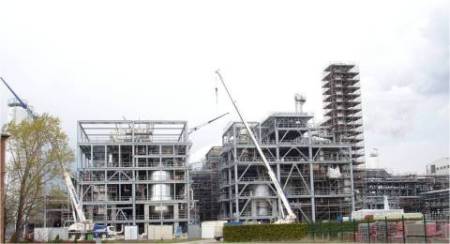Today Styron leaders joined employees, Dr. Reiner Haseloff, Minister-President of Saxony-Anhalt Germany and other dignitaries to celebrate the opening of Styron’s new SSBR (Solution Styrene Butadiene Rubber) production line.
 Construction on Styron's new Solution Styrene Butadiene Rubber (SSBR) production line in Schkopau, Germany was 60% complete in the Summer of 2012. (Photo: Styron)
Construction on Styron's new Solution Styrene Butadiene Rubber (SSBR) production line in Schkopau, Germany was 60% complete in the Summer of 2012. (Photo: Styron)
The new production line introduces an additional capacity of 50,000 metric tons at the production facility in Schkopau, Germany. This world-scale unit will begin operation as of today and supply Styron’s tire customers around the world.
Marco Levi, Styron’s Vice President and General Manager for Emulsion Polymers, described this expansion as a continuation of Styron’s history of growth in the rubber arena, with the most recent expansion in 2009 when the company brought another new SSBR train on stream.
“SSBR is a valued and strategic business within Styron and is core to the company’s growth plans. Since the company’s formation, the rubber business has been the top recipient of new capital investment,” said Levi. “Styron is dedicated to partnering with its customers to design and develop rubber technology that will help them upgrade their line of tires to address global trends and regulatory standards. We are innovating for tomorrow, on a platform of 75 years of rubber expertise.”
The new production train is built alongside existing trains, fully in line with initial construction plans, within budget and remarkably fast in comparison to projects of similar scale and complexity in the industry. The train focuses on SSBR production, with the capability to produce all existing clear and oil extended Styron grades.
According to Francesca Reverberi, Business Director for Rubber at Styron, Styron built this new train in response to the clear and increasing market need for high performance tires.
“Motivated by sustainability goals, driven by economical advantages and pushed by legislation and regulations, automobile producers and tire producers need to develop products with long life, fuel savings and safe technology. Accordingly, there is a need for tires with low rolling resistance combined with excellent wet grip and abrasion resistance in the tread,” explains Reverberi. “Using SSBR in the compounds is seen as a key enabling technology for delivering these three contradictory characteristics. Our people have the know-how to design the polymer but also to produce it on a big scale. Thanks to our R&D capabilities in Schkopau, the second generation SSBR technology, reduces the rolling resistance indicator up to 35% versus Generation 1 SSBR. We have an ongoing commitment to continue innovating for our customers and are already developing the third and fourth generation.”